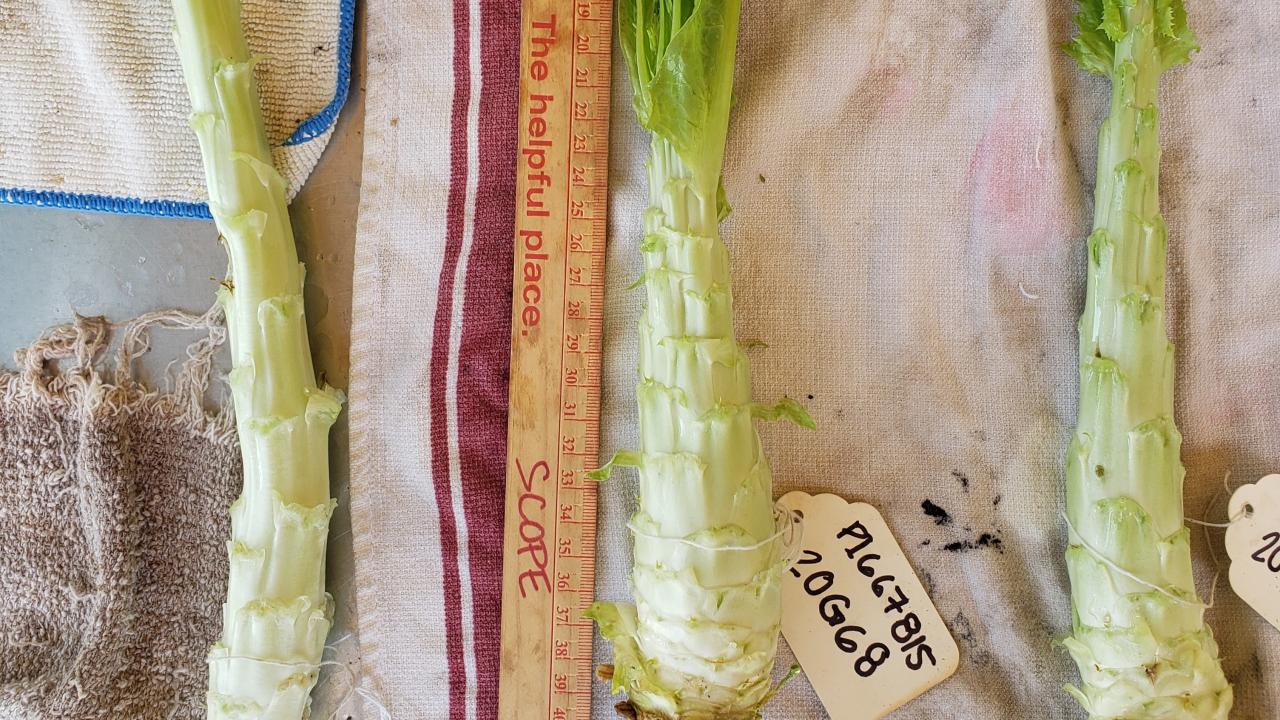
Meeting with Our Community Partners, Asian American Farmers, of the Participatory Breeding Project!
Getting Ready to Distribute F2 Generation Celtuce Seeds to Growers
Researchers at UC Davis SCOPE (Student Collaborative Organic Plant breeding Education) are partnering with the Department of Asian American Studies and local farmers in a participatory breeding trial to improve Celtuce varieties and explore their cultural importance to the Asian community. Celtuce is a variety of lettuce that is grown primarily for its stem. It is a popular Asian crop that can be eaten raw, pickled, or stir-fried. Most of the original parent lines we are working with came from Kristyn and her farmer network. These parent lines were crossed to produce F1 generation plants. The F1 generation self-pollinates to produce the F2 generation. The F2 generation seeds will be shared back with the farmers in return. The UC Davis SCOPE team is preparing the first distribution of segregating seeds for growers to observe the diversity and make selections of the traits they like to help shape our breeding goals.
As we get ready to distribute F2 generation celtuce seeds to growers, a collaborative meeting was held over zoom to better connect our researchers and growers beyond just google forms and emails. The participants in this meeting include growers from the Second Generation Seed network (Kristyn Leach, Julia Chang, Leslie, Adrienne Hohensee, Katharine Chiu), Prof. Ga Young Chung from the Department of Asian American Studies, and researchers from UC Davis SCOPE (Antonia Palkovic, Laura Roser, Prof. Charlie Brummer, and Huy Lin Lim). During the Celtuce trial, growers will receive F2 Celtuce crosses and their respective parent lines. They can collect data on traits such as stem length, stem diameter, stem and leaf color, leaf shape, etc. as metrics for comparison between varieties.
For the SCOPE team, our first step was to find out if these traits are reasonable for growers to track. In parallel, we also are actively trying to optimize and find easier and more efficient metrics of comparisons than what was written down. In the meeting, we learned that some growers sell Celtuce by count (ex. for CSA) and/or by weight (ex. for wholesale). As a result, stem length, diameter, and weights are important metrics that should be accounted for. To make it easier and faster for growers to segregate and differentiate diversity in Celtuce, we devised a set of ranges based on stem length and diameter. Stem lengths under 8”, between 8” to 15”, or over 15” are examples of the ranges used. We hope to maintain marketable stem length even as new development and optimization of other traits are worked upon. Weight is another important metric that varies depending on the severity of cut celtuce stem length and the number of leaves taken off. Therefore, to develop a consistent methodology for data collection, user variability needs to be taken into consideration.
Ways to streamline sharing of documents were also discussed. The goal is to make data entry and capturing easier for growers across different platforms. Google form is a quick and straightforward method that can be utilized for easier data entry in the field via a phone. Responses captured from google forms can formulate into a Master google spreadsheet that can be shared and viewed together. As a result, data across multiple growers can be synchronized into a single database.
To better shape and improve our trailing processes and methods for realistic data collection, feedback from growers was evaluated and reflected upon. Farmers suggested that a readily available reference sheet for metrics such as leaf shape would alleviate their stress and effort to sort and categorize. This is a great example of feedback that we hope to implement during the trial. Another great suggestion is to track the majority of the traits before the harvest date to minimize the farmers' stress during the busy harvesting time.
We then asked which cross growers are interested in receiving. The crosses we have available include red celtuce X green celtuce, celtuce X lettuce, early bolting X late bolting varieties, and/or any of those combinations. Red celtuce tends to bolt more quickly than green celtuce and does not produce a thick enough stem, so a cross between these two lines could produce an individual that is red with later bolting and a thicker stem than the existing red parent. Head lettuce is the same species as celtuce but tends to bolt later than celtuce and has a greater variety of interesting leaf textures/colors. Crossing celtuce with head lettuce could result in later bolting celtuce varieties with novel leaf textures/colors.
The seeds are packaged and ready to be sent out. We will continue to meet with farmers throughout the trial and update as we go.
